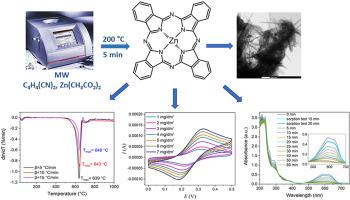针状锌酞菁的热稳定性增强,电化学和光催化性能优异
IF 5.1
2区 材料科学
Q1 MATERIALS SCIENCE, CERAMICS
引用次数: 0
摘要
本研究提出了通过环保型增强微波(MW)合成法在温度为 200 ℃ 的条件下 5 分钟制备的分层结构锌酞菁(ZnPc)样品,其热稳定性增强,电化学和光催化性能优异。通过 X 射线衍射 (XRD)、高分辨率透射电子显微镜 (TEM) 和原子力显微镜 (AFM) 对得到的 ZnPc 的结构和形貌进行了表征。同时,利用热重分析(TGA)和差热分析(DTA)分析了热稳定性。所获得的 ZnPc 结晶度高、晶相纯净,并出现了与 ZnPc β 形式相关的反射峰。根据 2θ = 9.30° 处的峰值,利用 Debye-Scherrer 公式确定了平均晶体尺寸 (D) 为 74 nm。原子力显微镜(AFM)图像显示 ZnPc 材料是一种独特的多层晶体,具有菱形晶体结构,表面看起来非常光滑;而 TEM 图像则显示合成的 ZnPc 自组织组装体具有分层结构,其形态呈针状,按不同方向排列,长度可达约 500 nm,直径为 20 nm。TGA 和 DTA 显示,在加热速率为 15 °C/min 时,分解过程发生在 649 °C 的高温下,这表明所研究的 ZnPc 具有良好的热稳定性。使用不同初始浓度的活性蓝 19(RB-19)、pH 值和催化剂剂量评估了分层结构 ZnPc 的光催化活性。此外,还研究了作为电极材料的 ZnPc 的电化学性能。这项研究表明,可以采用简便、低成本和绿色的 MW 方法制备针状 ZnPc,并将其作为一种具有潜在应用前景的多功能材料:用于未来太阳能发电技术中的热能储存;作为电极材料显示出卓越的伏安响应(阴极和阳极电流值);以及作为光催化剂降解 RB-19 和其他有机染料污染物。本文章由计算机程序翻译,如有差异,请以英文原文为准。

Enhanced thermal stability and excellent electrochemical and photocatalytic performance of needle-like form of zinc-phthalocyanine
This study proposes enhanced thermal stability and excellent electrochemical and photocatalytic performance of hierarchical structure of zinc-phthalocyanine (ZnPc) samples prepared through eco-friendly enhanced microwave (MW) synthesis over 5 min at T = 200 °C. The structure and morphology of the obtained ZnPc were characterized by X-ray diffraction (XRD), high-resolution transmission electron microscope (TEM), and Atomic Force Microscope (AFM). At the same time, thermal stability was analyzed using thermogravimetric analysis (TGA) and differential thermal analysis (DTA). The obtained ZnPc with high crystallinity, pure crystalline phases and reflection peaks related to the β-form of ZnPc. The average crystallite size (D) of 74 nm was determined using the Debye-Scherrer equation for a peak at 2θ = 9.30°. AFM image presented ZnPc material as a distinguished multilayered crystal with a rhombus-shaped crystal structure that seems very smooth on its surface, while TEM images showed a hierarchical structure of synthesized ZnPc self-organized assembles from the needle-like morphology which are aligned at different orientations having length up to approximately 500 nm and with 20 nm in diameter. TGA and DTA showed that the decomposition process occurred at a high temperature of 649 °C, for a heating rate of 15 °C/min, indicating good thermal stability of the investigated ZnPc. The photocatalytic activity of the hierarchically structured ZnPc was evaluated using different initial concentrations of Reactive Blue 19 (RB-19), pH value, and catalyst dose. Additionally, the electrochemical performance of ZnPc as electrode material was investigated. This study indicates facile, low-cost, and green MW method can be used for the preparation of the needle-like form of ZnPc as a promising multifunctional material for the potential applications: in thermal energy storage in future solar power technologies, as electrode material exhibiting superior voltammetric response, with cathodic and anodic current values and as photocatalyst for degradation of RB-19 and other organic dye-pollutants.
求助全文
通过发布文献求助,成功后即可免费获取论文全文。
去求助
来源期刊

Ceramics International
工程技术-材料科学:硅酸盐
CiteScore
9.40
自引率
15.40%
发文量
4558
审稿时长
25 days
期刊介绍:
Ceramics International covers the science of advanced ceramic materials. The journal encourages contributions that demonstrate how an understanding of the basic chemical and physical phenomena may direct materials design and stimulate ideas for new or improved processing techniques, in order to obtain materials with desired structural features and properties.
Ceramics International covers oxide and non-oxide ceramics, functional glasses, glass ceramics, amorphous inorganic non-metallic materials (and their combinations with metal and organic materials), in the form of particulates, dense or porous bodies, thin/thick films and laminated, graded and composite structures. Process related topics such as ceramic-ceramic joints or joining ceramics with dissimilar materials, as well as surface finishing and conditioning are also covered. Besides traditional processing techniques, manufacturing routes of interest include innovative procedures benefiting from externally applied stresses, electromagnetic fields and energetic beams, as well as top-down and self-assembly nanotechnology approaches. In addition, the journal welcomes submissions on bio-inspired and bio-enabled materials designs, experimentally validated multi scale modelling and simulation for materials design, and the use of the most advanced chemical and physical characterization techniques of structure, properties and behaviour.
Technologically relevant low-dimensional systems are a particular focus of Ceramics International. These include 0, 1 and 2-D nanomaterials (also covering CNTs, graphene and related materials, and diamond-like carbons), their nanocomposites, as well as nano-hybrids and hierarchical multifunctional nanostructures that might integrate molecular, biological and electronic components.
 求助内容:
求助内容: 应助结果提醒方式:
应助结果提醒方式:


